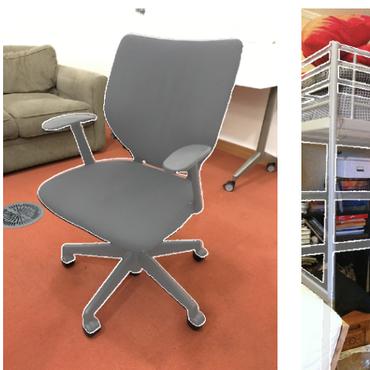Search Results for author: Ben Sapp
Found 10 papers, 2 papers with code
MotionDiffuser: Controllable Multi-Agent Motion Prediction using Diffusion
no code implementations • CVPR 2023 • Chiyu Max Jiang, Andre Cornman, Cheolho Park, Ben Sapp, Yin Zhou, Dragomir Anguelov
We present MotionDiffuser, a diffusion based representation for the joint distribution of future trajectories over multiple agents.
CausalAgents: A Robustness Benchmark for Motion Forecasting using Causal Relationships
1 code implementation • 7 Jul 2022 • Rebecca Roelofs, Liting Sun, Ben Caine, Khaled S. Refaat, Ben Sapp, Scott Ettinger, Wei Chai
Finally, we release the causal agent labels (at https://github. com/google-research/causal-agents) as an additional attribute to WOMD and the robustness benchmarks to aid the community in building more reliable and safe deep-learning models for motion forecasting.
VN-Transformer: Rotation-Equivariant Attention for Vector Neurons
no code implementations • 8 Jun 2022 • Serge Assaad, Carlton Downey, Rami Al-Rfou, Nigamaa Nayakanti, Ben Sapp
Rotation equivariance is a desirable property in many practical applications such as motion forecasting and 3D perception, where it can offer benefits like sample efficiency, better generalization, and robustness to input perturbations.
StopNet: Scalable Trajectory and Occupancy Prediction for Urban Autonomous Driving
no code implementations • 2 Jun 2022 • Jinkyu Kim, Reza Mahjourian, Scott Ettinger, Mayank Bansal, Brandyn White, Ben Sapp, Dragomir Anguelov
A whole-scene sparse input representation allows StopNet to scale to predicting trajectories for hundreds of road agents with reliable latency.
Occupancy Flow Fields for Motion Forecasting in Autonomous Driving
no code implementations • 8 Mar 2022 • Reza Mahjourian, Jinkyu Kim, Yuning Chai, Mingxing Tan, Ben Sapp, Dragomir Anguelov
We propose Occupancy Flow Fields, a new representation for motion forecasting of multiple agents, an important task in autonomous driving.
Scene Transformer: A unified architecture for predicting future trajectories of multiple agents
no code implementations • ICLR 2022 • Jiquan Ngiam, Vijay Vasudevan, Benjamin Caine, Zhengdong Zhang, Hao-Tien Lewis Chiang, Jeffrey Ling, Rebecca Roelofs, Alex Bewley, Chenxi Liu, Ashish Venugopal, David J Weiss, Ben Sapp, Zhifeng Chen, Jonathon Shlens
In this work, we formulate a model for predicting the behavior of all agents jointly, producing consistent futures that account for interactions between agents.
Scene Transformer: A unified architecture for predicting multiple agent trajectories
3 code implementations • 15 Jun 2021 • Jiquan Ngiam, Benjamin Caine, Vijay Vasudevan, Zhengdong Zhang, Hao-Tien Lewis Chiang, Jeffrey Ling, Rebecca Roelofs, Alex Bewley, Chenxi Liu, Ashish Venugopal, David Weiss, Ben Sapp, Zhifeng Chen, Jonathon Shlens
In this work, we formulate a model for predicting the behavior of all agents jointly, producing consistent futures that account for interactions between agents.
Large Scale Interactive Motion Forecasting for Autonomous Driving : The Waymo Open Motion Dataset
no code implementations • 20 Apr 2021 • Scott Ettinger, Shuyang Cheng, Benjamin Caine, Chenxi Liu, Hang Zhao, Sabeek Pradhan, Yuning Chai, Ben Sapp, Charles Qi, Yin Zhou, Zoey Yang, Aurelien Chouard, Pei Sun, Jiquan Ngiam, Vijay Vasudevan, Alexander McCauley, Jonathon Shlens, Dragomir Anguelov
Furthermore, we introduce a new set of metrics that provides a comprehensive evaluation of both single agent and joint agent interaction motion forecasting models.
Large Scale Interactive Motion Forecasting for Autonomous Driving: The Waymo Open Motion Dataset
no code implementations • ICCV 2021 • Scott Ettinger, Shuyang Cheng, Benjamin Caine, Chenxi Liu, Hang Zhao, Sabeek Pradhan, Yuning Chai, Ben Sapp, Charles R. Qi, Yin Zhou, Zoey Yang, Aurelien Chouard, Pei Sun, Jiquan Ngiam, Vijay Vasudevan, Alexander McCauley, Jonathon Shlens, Dragomir Anguelov
Furthermore, we introduce a new set of metrics that provides a comprehensive evaluation of both single agent and joint agent interaction motion forecasting models.
MODEC: Multimodal Decomposable Models for Human Pose Estimation
no code implementations • CVPR 2013 • Ben Sapp, Ben Taskar
Unlike other multimodal models, our approach includes both global and local pose cues and uses a convex objective and joint training for mode selection and pose estimation.






